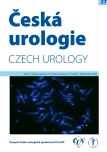The results of percutaneous nephrostomy tube placement under ultrasound guidance
Authors:
Simona Machynová 1; Michal Fedorko 1,2; Vítězslav Vít 1,2
Authors‘ workplace:
Urologická klinika FN Brno
1; LF MU Brno
2
Published in:
Ces Urol 2023; 27(2): 95-100
Category:
Original article
Overview
Goal: We would like to present the experiences of our department with nephrostomy tube placement under ultrasound guidance, considering the low number of articles on this topic.
Materials and Methods: In years 2018–2021, a total of 592 ultrasound-guided percutaneous nephrostomies were performed in 363 patients. The data was analyzed retrospectively. We evaluate the indications for the drainage of the upper urinary tract, the technical success rate and the number and type of complications.
Results: The most common oncological indication was the obstruction or infiltration of a ureter 284 (47,97 %); and the most common non-oncological indication was obstructive pyelonephritis 156 (26,35 %). During the observed period, the success rate was 90 %. The most frequent complication was nephrostomy drain dislodgment in 105 cases within 11 weeks after the insertion. Repeated dislodgement of percutaneous nephrostomies was significantly more common in patients with bilateral nephrostomies.
Conclusion: Percutaneous nephrostomy insertion under ultrasound guidance is a safe method for achieving upper urinary tract drainage.
Keywords:
complication – percutaneous nephrostomy – obstructive uropathy – ultrasound.
Sources
1. Goodwin WE, Casey WC, Wolf W. Percutaneous trocar (needle) nephrostomy in hydronephrosis. JAMA. 1955; 157: 891–4.
2. Partin AW, Dmochowski RR, Kavoussi LR, Peters CA. Campbell‑Walsh‑Wein Urology. 12th ed. Philadelphia, PA: Elsevier. 2021: 779–780.
3. Lynch MF, Anson KM, Patel U. Percutaneous nephrostomy and ureteric stent insertion for acute renal deobstruction: consensus based guidance. Brit J Med Surg Urol. 2008; 1: 120.
4. Pabon‑Ramos WM, Dariushnia SR, Walker TG, et al. Quality improvement guidelines for percutaneous nephrostomy. J Vasc Interv Radiol. 2016; 27: 410–4.
5. Skolarikos A, Neisius A, Petřík A, et al. EAU Guidelines on Urolithiasis. In: EAU Guidelines. Edn. presented at the EAU Annual Congress Amsterdam, 2022. Arnhem, The Netherlands: EAU Guidelines Office. 2022; 15–16.
6. Efesoy O, Saylam B, Bozlu M, Çayan S, Akbay E. The results of ultrasound‑guided percutaneous nephrostomy tube placement for obstructive uropathy: a single‑centre 10-year experience. Turk J Urol. 2018; 44: 329–34.
7. Mahmood T, Younus R, Ahmad F, Memon S, Moavia A. Ultrasound as a reliable guidance system for percutaneos nephrostomy. JCPSP. 2007; 17: 15–18.
8. Carrafiello G, Lagana D, Mangini M, et al. Complications of percutaneous nephrostomy in the treatment of malignant ureteral obstructions: single‑centre review. Radiol med. 2006; 111: 562–571.
9. Radecka E, Magnusson A. Complications of percutaneous nephrostomy in the treatment of malignant ureteral obstructions: single‑centre review. Acta Radiol. 2004; 45: 184–188.
10. Wah TM, Weston MJ, Irving HC. Percutaneous nephrostomy insertion: outcome data from a propspective multi‑operator study at a UK training centre. Clin Radiol. 2004; 59: 266–261.
11. Yoo MJ, Bridwell RE, Inman BL, Henderson JD, Long B. Approach to nephrostomy tubes in the emergency department. Am J Emerg Med. 2021; 50: 592: 596.
12. Navrátil P, Krajina A, Novák I. Nefrostomický drén zavedený do dolní duté žíly. In: 68. výroční konference České urologické společnosti 19.–21. 10. 2022. Ces Urol. 2022; 26(Suppl. A): 51.
13. Li T, Jiang Y, Chen J, Luo G, Sun F. Nephrostomy Tube Misplaced into the Right Atrium: An Extremely Rare Case and Review of the Literature. Urol Int. 2021; 105: 924–928.
Labels
Paediatric urologist Nephrology UrologyArticle was published in
Czech Urology

2023 Issue 2
Most read in this issue
- Prognostic factors in metastatic prostate cancer
- 5th edition of the 2022 WHO classification of prostate cancer: changes and novelties in the "Blue Book"
- Early complications after radical cystectomy before implementation of the ERAS concept (Enhanced Recovery After Surgery)
- The results of percutaneous nephrostomy tube placement under ultrasound guidance
